Life, Novels
MILICA JAKOVLJEVIĆ (1887-1952), FAMOUS AS MIR-JAM, CONTINUES BEING MOST POPULAR IN BOOKSTORES AND MOST WATCHED IN THEATERS AND TV
Mourning Chastity
She was the most read writer in the Kingdom of Yugoslavia and the sequels of her novels in the ”Nedeljne Ilustracije” magazine were awaited with excitement. In 1939, her drama ”There, Far Away” was triumphantly performed with Žanka Stokić as the leading actress. Then, after ”the revolution”, she was first harshly criticized, mocked, then moved aside. As if erased with a rubber. She withdrew from the arena of this world on December 22, 1952 in Belgrade, without even a note in the newspapers. Recently, 56 years later, over three million people were watching the series ”Wounded Eagle” shown on RTS evening after evening! The same is now with the series ”Sin of Her Mother”, also made according to her novel. What has attracted us so strongly?
By: Dragana Bukumirović
Photo: RTS
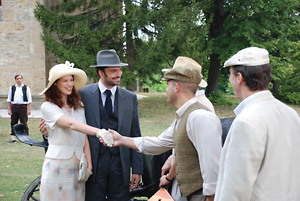 The room had a scent of dry leaves which the wind blew to the windows. Comfortably seated in the soft cushions, Milica hurried to write the last sentences of her romantic prose. The young man from the Weekly Illustrations newspaper will come any moment to pick up the sequel of her novel, which the female readers awaited with great impatience. The room had a scent of dry leaves which the wind blew to the windows. Comfortably seated in the soft cushions, Milica hurried to write the last sentences of her romantic prose. The young man from the Weekly Illustrations newspaper will come any moment to pick up the sequel of her novel, which the female readers awaited with great impatience.
The soother of female hearts wrote in the silence of her lonely house in Molerova St. 21, surrounded with comfortable sofas, Pirot rugs and embroidery. Exciting love stories were created in that literary workshop, predecessors of later ”love novels”, in which one could find love and suffering, and which entered the secret world of young women occupied with the dream of the love of their life. She left a voluminous opus and, for her time, was a true best-selling author. She did not pay attention to the fact that the prepotent critics never seriously considered her work, and put it aside as ”heartbreaking and sweetened”. She had her enormous audience who loved her unconditionally.
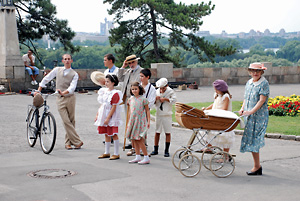 Then, after World War II, the order of things became completely different. Critics-commissaries, as social workers and supervisors in behalf of the communist authorities, accused her already before World War II (in the communist newspaper Woman Today) that she is a ”charlatan who heals people with cheap herbs”. After the war, many words more resembling accusations than literary qualifications were added. Provincialism, sentimentalism, hypocrisy of bourgeois ethics, insulting the woman as a comrade and pillar of a righteous socialist society… Then, after World War II, the order of things became completely different. Critics-commissaries, as social workers and supervisors in behalf of the communist authorities, accused her already before World War II (in the communist newspaper Woman Today) that she is a ”charlatan who heals people with cheap herbs”. After the war, many words more resembling accusations than literary qualifications were added. Provincialism, sentimentalism, hypocrisy of bourgeois ethics, insulting the woman as a comrade and pillar of a righteous socialist society…
Milica Jakovljević would probably not pay attention to this either. She would, like before, write. She would create her works, even just to put them in a drawer for other time, some other people. However, the ”new reality” could not initiate her pen.
PHENOMENON OF THE GREAT RETURN
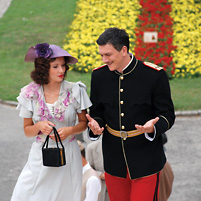 For decades, Milica Jakovljević and her works were covered with oblivion, heavy as the unjust conviction. Then, lately, publishers, script writers, directors suddenly remembered her. Fed up with Esmeraldas and Kasandras from Spanish and Latin American soap operas, they suddenly realized that they have a local true master in that domain. Then followed the great return of Mir-Jam to bookstores, theaters, and her real triumph in television (which did not exist at her time). Truly, television played the greatest part in her return, making her, in a way, our contemporary. In the TV series Wounded Eagle, written and directed by Zdravko Šotra, at RTS Program One, a few hundred actors relived the characters from the probably best book of Mir-Jam with the same title. For decades, Milica Jakovljević and her works were covered with oblivion, heavy as the unjust conviction. Then, lately, publishers, script writers, directors suddenly remembered her. Fed up with Esmeraldas and Kasandras from Spanish and Latin American soap operas, they suddenly realized that they have a local true master in that domain. Then followed the great return of Mir-Jam to bookstores, theaters, and her real triumph in television (which did not exist at her time). Truly, television played the greatest part in her return, making her, in a way, our contemporary. In the TV series Wounded Eagle, written and directed by Zdravko Šotra, at RTS Program One, a few hundred actors relived the characters from the probably best book of Mir-Jam with the same title.
There were also attempts in the past to do such a thing. The most famous dramatization, almost half a century ago, was the one written by Borislav Mihailović Mihiz and directed as a TV film by Soja Jovanović. However, it was not even close to the present record ratings of Šotra’s version. Furthermore, the ”Atelje 212” theater included the play Wounded Eagle in its repertoire two years ago.
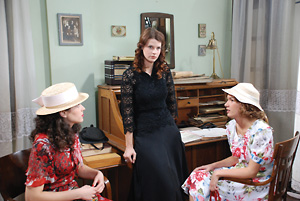 The great return of a previously beloved writer began with the publishing of her collection of works. All eleven novels came to bookstores (Man’s Word of Honor, Lady in Blue, Green Eyed Girl, Sin of her Mother, Little Wife, Invincible Heart, Abduction of a Man, Wounded Eagle, Single in Marriage, They All Love Love, In the Slovenian Mountains). Almost no one was interested. The predetermined lists of bestsellers, which most often proclaim as spectacular some hardly passable and completely anonymous foreign scribbler, never even mentioned the return of Milica Jakovljević. There was more talk and writing about the copyright dispute involving ”Narodna knjiga”, ”Draganić” and their successors. The great return of a previously beloved writer began with the publishing of her collection of works. All eleven novels came to bookstores (Man’s Word of Honor, Lady in Blue, Green Eyed Girl, Sin of her Mother, Little Wife, Invincible Heart, Abduction of a Man, Wounded Eagle, Single in Marriage, They All Love Love, In the Slovenian Mountains). Almost no one was interested. The predetermined lists of bestsellers, which most often proclaim as spectacular some hardly passable and completely anonymous foreign scribbler, never even mentioned the return of Milica Jakovljević. There was more talk and writing about the copyright dispute involving ”Narodna knjiga”, ”Draganić” and their successors.
Zdravko Šotra, however, estimated well: after all the horrors and violence, after the triumph of cruelty and vulgarity, the audience was eager for romance. A light love story, ”with the naivety of a time when order and taste were respected”, luxurious costumes, the beautiful face of Serbia, Herzegovina and the Coast, attracted three million viewers each evening. Dejan Andjelić, scenographer, completely dressed a street in Trebinje into an old gown, returning it the charm of a past time. It paid off. It has been a long time since a local love melodrama ignited the audience!
PREMEDITATED IDYLL
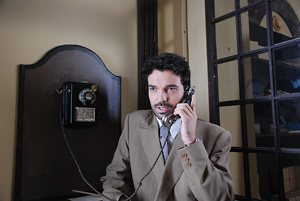 What is it in the work of this chronicle-writer of an ascending society such as the Serbian was in the 1930s, with all its rituals, ethics, customs, fashion… that attracts the attention of today’s audience? Perhaps there is truth in the belief that the past was more beautiful of more peaceful than the present? If we set aside the trivial plot and a bitter tear or sigh too many, isn’t the attractiveness of that ”premeditated idyll” much more than plain nostalgia? The conversations in Serbian houses, like on the pages of these works, began ritually, with coffee, jam and water, while the girls sat and waited for the gentlemen to address them, never beginning the conversation first. Oh, those modest madams! Can you see them anywhere today? What is it in the work of this chronicle-writer of an ascending society such as the Serbian was in the 1930s, with all its rituals, ethics, customs, fashion… that attracts the attention of today’s audience? Perhaps there is truth in the belief that the past was more beautiful of more peaceful than the present? If we set aside the trivial plot and a bitter tear or sigh too many, isn’t the attractiveness of that ”premeditated idyll” much more than plain nostalgia? The conversations in Serbian houses, like on the pages of these works, began ritually, with coffee, jam and water, while the girls sat and waited for the gentlemen to address them, never beginning the conversation first. Oh, those modest madams! Can you see them anywhere today?
Milica Jakovljević is the writer of such a patriarchal Serbia, with all its values also she blindly abided. And that was the secret of her success then. What about today? Is it the return of tenderness and romance which were considered irreversibly lost? What does that new longing for old innocence reveal to us?
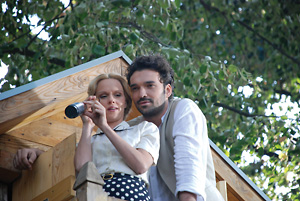 ”There are no ideal men, nor are the girls like they used to be”, wrote Mir-Jam with inspiration. ”Girls today want to be equal and free like men. They are not afraid of being condemned by the society. They consider it a natural way of life, they step forward boldly and live their lives like men… They defy life… Don’t forget yourself before marriage! Don’t look for instant pleasure. Preserve yourself for happiness and bliss in marriage, preserve yourselves in order to be respected by your husbands, so that they can never justify their actions with your sin”… ”There are no ideal men, nor are the girls like they used to be”, wrote Mir-Jam with inspiration. ”Girls today want to be equal and free like men. They are not afraid of being condemned by the society. They consider it a natural way of life, they step forward boldly and live their lives like men… They defy life… Don’t forget yourself before marriage! Don’t look for instant pleasure. Preserve yourself for happiness and bliss in marriage, preserve yourselves in order to be respected by your husbands, so that they can never justify their actions with your sin”…
Mir-Jam preached happiness in marriage, although she herself never experienced it. As if she had lived it through her numerous characters.
An ideal woman for Jakovljević is not a ”free minded” woman. She did not accept the ”new time”, neither in terms of taste, nor ethics. Absolute freedom and relative responsibility – this was not her world.
She withdrew even deeper into the loneliness of her hidden house, drew curtains on the windows, distancing herself from her neighbors (who did not know her any more) and from the time (which she did not want to understand). When she would go for a walk, she would wear a purple pelerine over dark clothes, sad remains of the vanished bourgeois world, replaced after the war with communist fashion: dark blue skirts and white blouses.
She turned her back to the new authorities and the new time.
Her way of rebellion.
SERBIAN JANE EYRE
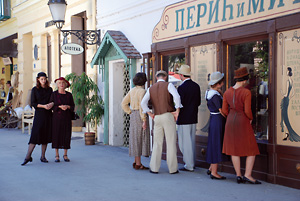 Who is the woman who made a commotion with her pen and raised a high defensive wall around herself in the days of her greatest glory? Who is the woman who made a commotion with her pen and raised a high defensive wall around herself in the days of her greatest glory?
The writer whom people called ”Serbian Jane Eyre” was born in Jagodina, on April 22, 1887. Her father Jakov was the County chief. He was widowed twice. He had no children in his first marriage, and eight in the second. When he could not take care of them any more, his friends talked him into marrying Simka. Everyone thought she cannot have children. However, strangely, after marrying Jakov she had twins who died at birth, and then Milica, Stevan and Zora.
Milica spent her childhood in Kragujevac, and moved to Belgrade after World War I. She was a teacher for a while, and then reporter in Belgrade News and Weekly Illustrations. Beautiful, blond, she was more educated than her contemporaries, spoke two languages (French and Russian), read Rabelais in original. She spent the early years of her teenage l ife with her family, later suffered worrying about her brother Stevan Jakovljević, writer of the famous Serbian Trilogy, who took part in the liberation wars from 1912 to 1918 as an officer of the Serbian Army. When the war ended, Milica was 27, and, for that time, considered an ”old maid”. ife with her family, later suffered worrying about her brother Stevan Jakovljević, writer of the famous Serbian Trilogy, who took part in the liberation wars from 1912 to 1918 as an officer of the Serbian Army. When the war ended, Milica was 27, and, for that time, considered an ”old maid”.
Just like Jane Austen (1775-1817), with which they compared her, she had a chance to get married, but refused the offer. Her exciting ten-year romance with a Smederevo actor Boža Nikolić therefore never ended with a wedding (although they, in order to avoid gossips, spread the news that they live in a civil marriage).
She withdrew from the arena of this world on December 22, 1952 in Belgrade, without even an obituary in the newspaper. She signed all her literary works with a pseudonym Mir-Jam, which in Hebrew means Beloved Woman.
***
Sin of Her Mother
Since November 20, 2009, in RTS prime time (each Friday at 8 p.m.), we have been watching 18 one-hour episodes of Sin of Her Mother, written and directed by Zdravko Šotra according to the novel with the same name written by Mir-Jam.
Besides Šotra, the team includes producer Zoran Janković, editor-in-chief Slobodan Terzić, and, besides with many experienced first-class actors, Ivana Janković had her acting debut and the series launched her as a star.
The project was realized very quickly, in only 88 days, i.e. less then five days per episode. It was shot in Sremski Karlovci, in the villages of Šumadija, Srem and Bačka, in Palić, on the banks of the Drina near Loznica and in Belgrade. It was produced by RTS and ”Košutnjak Film”.
”If Wounded Eagle is the best known novel of Mir-Jam, Sin of Her Mother is the most intriguing, and as such perfect for television adaptation”, say people from RTS.
***
Stevan
Milica’s brother Stevan Jakovljević (1890-1962), professor at the Belgrade University and rector from 1945-1950, ended as a clerk in Radio Beograd. He, the author of the famous Serbian Trilogy (some say that the romantic dialogues in the novel were written by his sister Milica), doctor of biology and professor at the Faculty of Pharmaceutics, officer of the Serbian Army during the war, was also pushed into oblivion. Will the return of the great interest for his sister Milica and her literary work direct at least some of the deserved new attention to him too, who obviously is not popular in some circles today just like his sister was not after ”that revolution”?
***
Comparison
The English Jane Austin and Serbian Mir-Jam were called sisters in pen, with similar romantic sensibility and achievements. Although many people did not give any compliments to her work, and Mark Twain even said that ”any library without Jane Austin’s books is a good library, even if it has no other book”, the English woman became very famous, and remained so until the present day. The house she spent her last eight years in is a museum today. She is considered one of the ”most important authors of classic English literature”, and some even, certainly too bravely, compare her with Shakespeare.
Milica Jakovljević left the stage of this world without a single note in the newspaper, and the house in Molerova St., where she wrote all her books, was torn down. There is no memorial plate, no bust, not even a street carrying her name.
***
Among One Hundred
Almost half a century later, in the late XX century, Milica Jakovljević was enlisted among one hundred most important Serbian reporters in the period from 1791 to 1991. Besides her, also listed are Maga Magazinović and Desa Glišić. Only three women!
***
Theater
Milica Jakovljević was a regular visitor of the National Theater, not only because she liked to watch the plays, but also because going to the theater was a good opportunity for her to dress up. She carefully chose her clothes, hats (which she loved), scarves, jackets. Her beauty and eccentricity attracted common attention. She admired Ljubinka Bobić, whom she called little Boba, Mata Milošević, Svetolik Nikačević, Žanka Stokić… In 1939, she was courageous enough to write a theatrical play ”There, Far Away”, triumphantly performed with Žanka Stokić as the leading actress.
|
